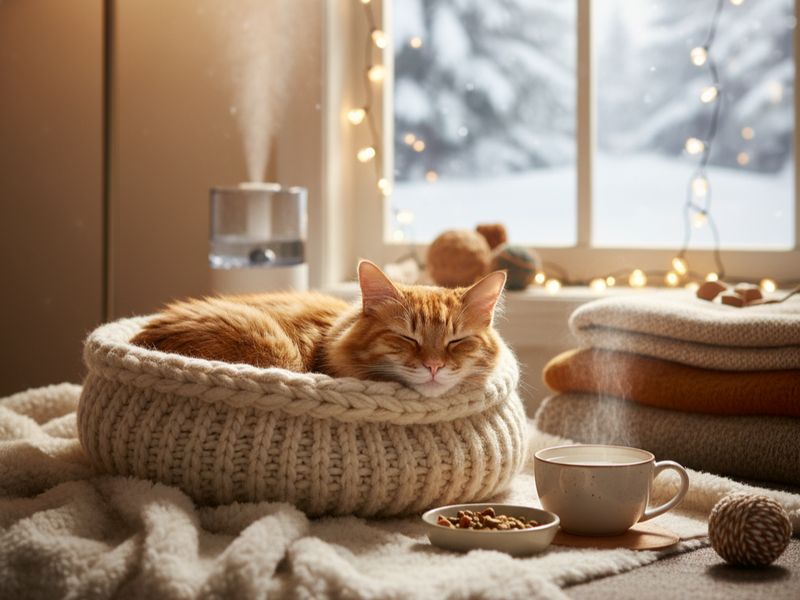In this Article
As a lifelong cat parent and feline wellness enthusiast, I’ve seen how winter can quietly change a cat’s daily habits. This article was born from that experience — to help every cat owner make the cold season not just bearable, but cozy and full of warmth.
❄️ Introduction: Winter Isn’t Just Tough for Humans
When the temperature drops, cats may seem unfazed — after all, they curl up in a ball and look perfectly content. But in reality, winter can bring new challenges to your feline’s health and comfort. Dry air, cold floors, and seasonal viruses can all take their toll.
The good news? A few thoughtful adjustments can help your cat stay warm, healthy, and happy all winter long.
🌡️ Temperature and Heating: Finding the Sweet Spot
Cats prefer warmer indoor temperatures than humans — ideally around 20–24°C (68–75°F).
Tips to maintain the right temperature:
- Avoid placing your cat’s bed near drafts, doors, or windows.
- If your floors are tiled or hardwood, provide soft rugs or mats to prevent cold paws.
- Use pet-safe heating pads or self-warming beds. Many modern options use your cat’s body heat, avoiding electricity altogether.
- Never let cats sleep directly on radiators or near heaters — burns and dehydration can occur.
Pro Tip: Observe where your cat naps. If she starts curling up on electronics, radiators, or under blankets, she’s telling you it’s too chilly.
🛏️ Cozy Sleeping Spots: Build a Feline Winter Retreat
Every cat deserves a warm and inviting corner during the colder months.
Try these cozy setups:
- Soft wall-mounted beds: Cats love elevated spots where warm air rises. A cushioned wall hammock or plush mounted cave offers security and heat retention.
- Heated cat mats or thermal blankets: Place them in your cat’s favorite nap area. Always choose low-voltage, chew-resistant designs.
- Blanket nests: Layer fleece blankets or soft throws in a basket or cat cave. Cats adore materials that trap warmth but still allow airflow.
Bonus idea: Place a wall bed or hammock near a sunny window for natural warmth during the day — just make sure the area is draft-free.
🧴 Winter Grooming: Keep That Coat in Shape
It might seem logical to groom less in winter, but cats still shed, even in the cold. Regular brushing helps prevent matting, dry skin, and hairballs — all of which can increase during heated indoor months.
Grooming checklist:
- Brush long-haired cats daily, short-haired breeds every 2–3 days.
- Use a slicker brush or de-shedding tool to remove dead fur.
- Wipe your cat with a damp microfiber cloth to reduce static and dust.
- Watch for dry skin or dandruff — if it appears, consider a humidifier or omega-3 supplements (after consulting your vet).
Why grooming matters in winter: Dry air causes the coat to lose moisture, and less sunlight can affect natural oils in the fur. Grooming helps distribute those oils evenly, keeping the coat soft and protective.
💧 Humidity and Hydration: The Unsung Heroes of Winter
Central heating keeps us warm but also dries the air, which can affect your cat’s nose, skin, and respiratory system.
Here’s how to maintain healthy humidity (30–50%) indoors:
- Use a humidifier — ideally a quiet, cool-mist one.
- Place cat-safe plants (like spider plants or areca palms) to naturally boost moisture and improve air quality.
- Provide multiple water bowls or a fountain — cats drink more when water moves.
Hydration tip: Some cats drink less in winter because they eat more wet food. Monitor water intake and mix a bit of warm water into meals if needed.
🩺 Health & Prevention: Winter Wellness Routine
Cold weather doesn’t directly cause illness, but it can weaken immunity. Make sure your cat’s preventive care is up to date.
Winter health checklist:
- Schedule a vet check-up before winter to ensure vaccines and parasite prevention are current.
- Watch for signs of respiratory infections — sneezing, watery eyes, or lethargy.
- Avoid exposure to cold drafts after baths or outdoor time.
- Consider joint supplements for older cats — cold temperatures can make arthritis symptoms worse.
If your cat goes outdoors, ensure a warm, waterproof shelter is available and always wipe their paws after coming in — road salt and ice melt chemicals are toxic if licked.
🍲 Nutrition Boost: Feeding for Warmth
A cat’s metabolism may change slightly in winter. Outdoor cats, or those in cooler homes, might need a small increase in calories to maintain body temperature.
Feeding tips:
- Offer high-quality protein-rich wet food.
- Serve meals slightly warmed (never hot).
- Add fish oil or omega-3s for coat health — but consult your vet first.
Remember: sudden diet changes can cause stomach upset, so adjust gradually.
💗 Conclusion: Warmth, Wellness, and Love
Your cat relies on you to keep her safe and snug when the days grow cold. By adjusting the environment, maintaining grooming routines, and monitoring health, you can make winter a season of comfort instead of concern.
So grab a cozy blanket, pour yourself a hot drink, and watch your cat nap peacefully in her warm corner — the true picture of winter happiness.
💬 End Note
How does your cat spend the winter months? Share your favorite cozy-cat stories or photos in the comments below — we’d love to hear them!


